Shetland Ponies In The Snow
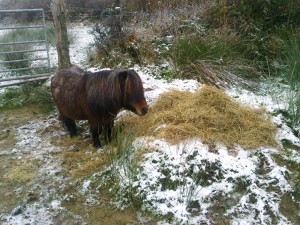 Recently we’ve had a lot of cold, bitter weather with temperatures going below freezing for several days in a row. Every morning for the last week or so, at around 7am I went down to my ponies’ fields and ended up having to break the ice on their water buckets and troughs – mostly there was just about an inch of ice. It’s important to do this as ponies, like all animals, need a constant supply of water.
Recently we’ve had a lot of cold, bitter weather with temperatures going below freezing for several days in a row. Every morning for the last week or so, at around 7am I went down to my ponies’ fields and ended up having to break the ice on their water buckets and troughs – mostly there was just about an inch of ice. It’s important to do this as ponies, like all animals, need a constant supply of water.
This morning when I looked out the window I was greeted with the beautiful sight of my snowy front garden and the fields beyond. Yes, snow and lots of it. Now, every year when I see the first of the snow I always feel that little bit of excitement and magic, and today was no different! Ok, it wasn’t really the first of the snow, as we had a light sprinkling yesterday but nothing dramatic.
As soon as I got up, I wrapped up warmly and ventured outside. After all my Shetland ponies, who live outside most of the year round, were going to be hungry as all the grass was covered with snow! It was time to start lugging trugs and barrows full of hay down to them.
Now, in the winter I find that you only need to bring hay down for ponies if the grass is brown and inedible, or very wet and water-logged or covered in snow. Today (well actually last night too) was when the first of the major snow came and so I’ve only just started taking out loads of hay to them, as the grass has still been very nutritious and green enough for them to eat up until now. Last night, after looking at the weather forecast, and seeing the predicted snow for the today and the light covering we had then, I took a trug of hay out to them in preparation.
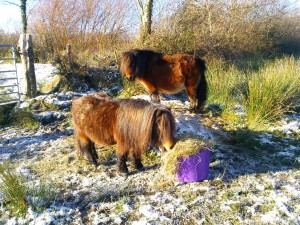 Many owners aren’t sure whether they should let their equines out in the snow as they’re worried it may be too cold for them – this does depend on the breed. In general it is fine to keep Shetland ponies outside in the winter, day and night, even in snow (although if it starts ‘blizzarding’ heavily you may want to take them into a stable). If you have a race horse or a breed which hasn’t much of a thick coat, I would be skeptical about letting them out in the snow for long periods of time.
Many owners aren’t sure whether they should let their equines out in the snow as they’re worried it may be too cold for them – this does depend on the breed. In general it is fine to keep Shetland ponies outside in the winter, day and night, even in snow (although if it starts ‘blizzarding’ heavily you may want to take them into a stable). If you have a race horse or a breed which hasn’t much of a thick coat, I would be skeptical about letting them out in the snow for long periods of time.
Shetland ponies come from the Shetland Isles, near Scotland, where the weather is often very bleak and very cold. This is why Shetlands have much thicker coats than other ponies as they need to be able to withstand very cold temperatures. On Shetland, there are very few trees (if any) so most of the Shetland ponies have no shelter and simply turn their backs to the wind. This is their natural habitat and these ponies are adapted to live in such conditions, so they don’t necessarily need to come inside in snowy weather.
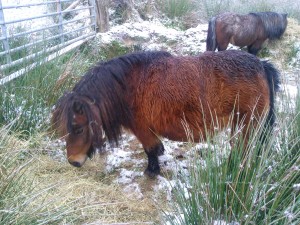 My ponies are pedigree Shetlands with pure blood lines, so they have lovely thick, soft coats that keep them very warm in winter. (They also look very cute in the snow!).
My ponies are pedigree Shetlands with pure blood lines, so they have lovely thick, soft coats that keep them very warm in winter. (They also look very cute in the snow!).
In winter, when there is no grass, and you’re taking hay down to your Shetlands, you should always take it to them at the same time. It is also important that you provide enough hay for them, it’s better to give too much than too little. You’ll be able to tell how much to give each day by seeing how much is left from the previous day. For my ponies, I find that a trug full of hay is enough for one pony for one day and night; although this can vary from pony to pony and the size of the trug.
Where To Put The Hay
I never put hay out in the open, unless there is definitely no chance of bad weather. Instead I always put the hay under a hedge or under shelter of some sort, as this will keep off most of the snow and rain. If the hay gets wet, the ponies aren’t likely to eat it and so will be hungry.
In my ponies’ fields there is a central hedge and bank that runs down the center, that is sheltered from both sides, by trees. There are also several places the bank has crumbled away, allowing the ponies, and I, to go inside the hedge. It is very dry inside and makes an ideal place to put the hay, although I don’t often put it here as I don’t want the ponies to be scrambling around, and fall off the bank. If I do put it inside the hedge (in the very wide part), I always put the hay at the side, and on top of some of the lower branches, as it stops the hay getting wet from the ground, and the ponies trampling all over their food.
Most of the time I put the hay under the sides of the ‘central hedge’ and under and on top of parts of the gorse hedge that goes around the perimeter of the field, as there’s more room and less chance of my ponies ‘falling off’ the bank.
If I can I avoid putting the hay on the ground, as it is likely to get very wet; instead I put the hay on top of branches that have other branches higher up that will shelter the hay. This way I know that if it’s snows a lot and there’s about four inches on the ground, the ponies will still be able to eat that hay, and that it shouldn’t have got wet.
I always try to vary where I put the hay; I’ve found that if you put it in the same place everyday, that area quickly becomes churned up by the hooves and very muddy.
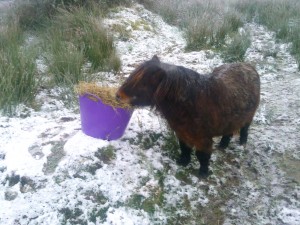 Other foods I feed my ponies are fresh vegetables, (that aren’t frozen), such as carrots and pieces of apple. About once or twice a week I may also give them about a half a handful of pony nuts each in a bucket (I’m scepticle of feeding this a lot though as too much can course laminitus, which shetladns are prone to).
Other foods I feed my ponies are fresh vegetables, (that aren’t frozen), such as carrots and pieces of apple. About once or twice a week I may also give them about a half a handful of pony nuts each in a bucket (I’m scepticle of feeding this a lot though as too much can course laminitus, which shetladns are prone to).
Another one of the joys of winter combined with keeping Shetland ponies is breaking the ice on water troughs and carrying bucketfuls of water to their fields. In our main field where our ponies are there’s a big water trough, that’s raised up slightly on concrete; this trough automatically fills up with water – however in the winter the pipes are often frozen. About thirty feet away we also have a bucket of water, in a tyre to stop it being kicked over, as Gradbach (our stallion) is slightly smaller than Tulip and finds it harder to reach the trough. Both the trough and bucket were frozen over. With my foot, I was able to break the ice, then pick it out of the bucket/trough and throw it over the fence. I have to be careful when breaking the ice in the bucket with my foot as I don’t want to break the bucket too!
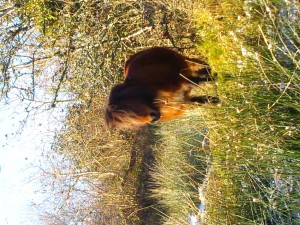 After I had sorted all of this out, I went for a walk with my dad to the bottom of the field on the slope. As we were standing talking, Gradbach and Tulip both came galloping down towards us at high speed, heading straight for us! At the last possible moment they both veered to the left. They then began to run around us, bucking and jumping, spraying up snow everywhere! (I was a little worried about Tulip as she’s heavily in foal, and we don’t want her straining herself, but then she seems to be ok, and really happy running around). Shetland ponies really do love to play in the snow like little children do!
After I had sorted all of this out, I went for a walk with my dad to the bottom of the field on the slope. As we were standing talking, Gradbach and Tulip both came galloping down towards us at high speed, heading straight for us! At the last possible moment they both veered to the left. They then began to run around us, bucking and jumping, spraying up snow everywhere! (I was a little worried about Tulip as she’s heavily in foal, and we don’t want her straining herself, but then she seems to be ok, and really happy running around). Shetland ponies really do love to play in the snow like little children do!
 November 28, 2010
·
November 28, 2010
·  Maddia (Admin) ·
Maddia (Admin) ·  Comments Closed
Comments Closed
 Tags: feeding ponies in the snow, feeding shetland ponies in the snow, My Shetland Ponies, shetland ponies, shetland ponies in the snow · Posted in: Horse and Pony Breeds, Horse and Pony Care, Horse and Pony Information, My Pet Updates
Tags: feeding ponies in the snow, feeding shetland ponies in the snow, My Shetland Ponies, shetland ponies, shetland ponies in the snow · Posted in: Horse and Pony Breeds, Horse and Pony Care, Horse and Pony Information, My Pet Updates


